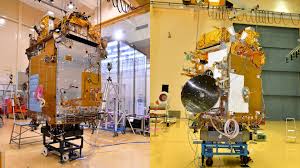ISRO Plans to Initiate India’s Inaugural Sun Mission on September 2nd
ISRO has declared that Aditya-L1, India’s inaugural solar mission, is set for launch from Sriharikota on the morning of September 2.

A mere ten days subsequent to the historic achievement of successfully landing Chandrayaan-3, the nation’s third lunar spacecraft, on the Moon’s south polar region, the Indian Space Research Organisation (ISRO) is prepared to mark yet another significant milestone.
The organization revealed on Monday that the departure of Aditya-L1, India’s premier mission to study the Sun, is planned for the morning of September 2 from the Sriharikota launch site.
🚀PSLV-C57/🛰️Aditya-L1 Mission:
The launch of Aditya-L1,
the first space-based Indian observatory to study the Sun ☀️, is scheduled for
🗓️September 2, 2023, at
🕛11:50 Hrs. IST from Sriharikota.Citizens are invited to witness the launch from the Launch View Gallery at… pic.twitter.com/bjhM5mZNrx
— ISRO (@isro) August 28, 2023
“The PSLV-C57/Aditya-L1 Mission is all set for its launch on September 2, 2023, at 11:50 AM IST from Sriharikota, as announced by ISRO in a statement released on Monday.
In the previous week, HT had provided information about ISRO’s intention to target a launch window spanning from September 1 to September 5, with a preference for the date of September 2.

The upcoming Aditya-L1 mission, signifying India’s inaugural endeavor to study the Sun from space, is poised to offer Indian scientists the opportunity to gain novel insights into the heart of our solar system.
Positioned in a halo orbit around Lagrange point 1 (L1) within the Sun-Earth system, approximately 1.5 million km away from Earth, the spacecraft’s mission is to unlock valuable information.

Initially conceived as Aditya-1, the mission involved a 400 kg satellite equipped with a singular payload – the Visible Emission Line Coronagraph (VELC). The original plan aimed for a launch into an 800-km low Earth orbit.”

However, owing to the significant advantage of an uninterrupted view of the Sun without encountering eclipses or occlusions when placed in the halo orbit encircling the first Lagrangian point (L1) in the Sun-Earth system, the original Aditya-1 mission underwent a name change to become the Aditya-L1 mission.

A Lagrange Point denotes a specific location in space where the gravitational forces of nearby celestial bodies counteract each other, allowing an object to maintain a state of equilibrium.
ISRO scientists have explained that the instrumentation of Aditya-L1 is meticulously calibrated to primarily observe the solar atmosphere, specifically the chromosphere and the corona, which constitute the Sun’s outermost layers. These instruments will closely monitor the local environment at L1 while conducting remote sensing and observations.
The Aditya-L1 spacecraft hosts a total of seven payloads, encompassing both remote sensing and in-situ tools. Among the remote sensing payloads are the Visible Emission Line Coronagraph (VELC), Solar Ultraviolet Imaging Telescope (SUIT), Solar Low Energy X-ray Spectrometer (SoLEXS), and High Energy L1 Orbiting X-ray Spectrometer (HEL1OS). The in-situ payloads comprise the Aditya Solar Wind Particle Experiment (ASPEX), Plasma Analyser Package For Aditya (PAPA), and Advanced Tri-axial High Resolution Digital Magnetometers. These payloads collectively facilitate observations of the photosphere, chromosphere, and the outermost solar layer (corona) using electromagnetic, particle, and magnetic field sensors.
The mission’s primary objectives encompass the examination of dynamic processes within the solar upper atmosphere, specifically the chromosphere and corona. This entails studying the heating mechanisms of these regions, delving into the behavior of partially ionized plasma, investigating the triggers behind coronal mass ejections and flares, and observing the localized particle and plasma environment for comprehensive insights into solar particle dynamics.
Furthermore, the mission seeks to unravel the intricacies of solar corona and its heating process, to carry out diagnostics on the plasma within coronal loops—evaluating parameters such as temperature, velocity, and density—and to conduct a thorough analysis of the magnetic field’s topology and measurements within the solar corona. Additionally, the mission aims to understand the influential drivers of space weather.
Operational from the unique vantage point of L1, four payloads are positioned for direct solar observation, whereas the remaining three payloads engage in in-situ examinations of particles and fields at Lagrange point L1. This comprehensive approach offers vital scientific insights into how solar dynamics propagate through the interplanetary medium.
In its mission document that was released in July, Isro said, “The suits of Aditya-L1 payloads are expected to provide the most crucial information to understand the problem of coronal heating, coronal mass ejection, pre-flare and flare activities and their characteristics, dynamics of space weather, propagation of particles and fields.”
